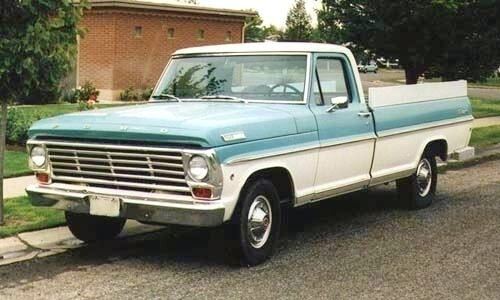 | ||
Assembly Valencia, Carabobo, Venezuela (Valencia Assembly)Cuautitlan, MexicoDearborn, Michigan, USAEdison, New Jersey, USAKansas City, Missouri, USALong Beach, California, USANorfolk Assembly (Norfolk, Virginia, USA)St. Paul, Minnesota, USASt. Louis, Missouri, USAGeneral Pacheco, Argentina (Ford Argentina)Casablanca, ChileSão Paulo, Brazil (Ford Brazil)Hapeville, Georgia, USALouisville, Kentucky, USASan Jose, California, USAWayne, Michigan, USAOakville, Ontario (Oakville Assembly), CanadaCampbellfield, Australia (Ford Australia) | ||
The fifth generation of the Ford F-Series is a line of pickup trucks and commercial trucks that were produced by Ford from 1966 to 1972. Built on the same platform as the fourth generation F-series trucks, the fifth generation had sharper styling lines, a larger cab and greenhouse, and expanded engine options.
Contents
Three trim levels were available during the production of the fifth generation F-series, though the names were changed in 1970. The "Base" trim became the "Custom" and the "Custom Cab" became the "Sport Custom" joining "Ranger" as optional levels of equipment and trim. Late in production the Ranger trim level was upgraded with the additional "Ranger XLT" option.
Year by year changes
Special models
After the 1968 model year, Ford discontinued the "Low GVWR" versions. Still available was the Camper Special option (heavy duty cooling, camper pre-wiring, and larger alternator) along with the new Explorer Special (a limited edition trim and option package that combined many of the "Ranger" trim pieces with a lower overall price), Contractor's Special (including a behind the seat toolbox and 3/4 ton (F-250) suspension), Farm and Ranch Special (extra toolboxes and heavy springs), and Heavy-Duty Special (extra hauling abilities). These special models had various levels of options factory installed to appeal to different target groups.
Brazil
The fifth-generation F-Series was introduced in Brazil in 1971, where it remained in production until circa 1992. It received a series of changes and updates over the two decades of production, eventually being fitted with a 4-cylinder MWM 3.9 liter Diesel engine available in both naturally-aspirated (D229-4) and turbocharged versions (TD229-4) in a local equivalent to the F-250 badged as F-1000, also available with a 6-cylinder 3.4 liter engine both in gasoline and dedicated-ethanol versions, while the F-100 retained the gasoline-powered Y-Block 272 V8 and the Georgia OHC 2.3L 4-cyl in both gasoline and dedicated-ethanol versions. It was the last Ford truck manufactured in the Ipiranga plant which closed soon after the truck's discontinuation. Brazilian F-100 and F-1000 were only available with a single cab and 2-wheel drive, but a number of local specialists custom-built double cabs, and Engesa provided an aftermarket 4-wheel drive conversion.
Models
Styleside on F-100 and F-250. 6.5' and 8' lengths.
Flareside on all models, 6.5', 8' and 9' (F-350 only) lengths.
Platform stakes on F-250 and F-350 in 9' and 12' lengths.
Standard cab on all models.
Crew cab with seating for six and four doors optional on F-250 and F-350.
Medium-Duty F-series
The heavier duty models (F-500 and up) continued to be built on the fifth generation chassis even after the lighter-duty models were replaced. In 1977 the lightest F-500 was discontinued, leaving the F-600 as the lightest of the medium-duties. It was built until the introduction of the seventh generation F-series in late 1979.
